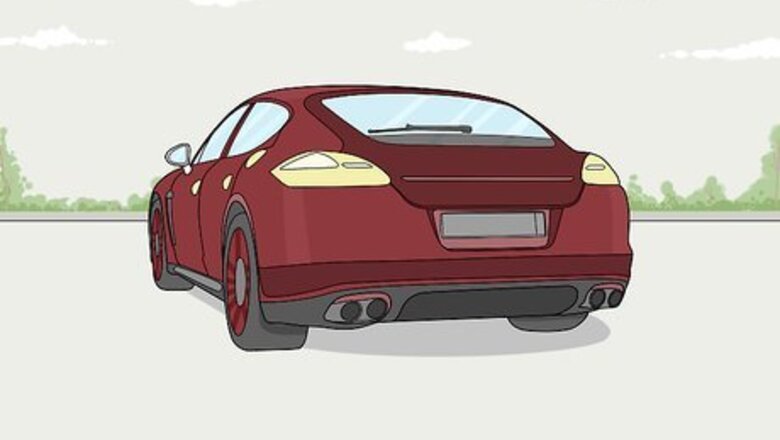
views
Reading the Clutch Fluid Level

Park the car on a hard, level surface before opening the hood. The clutch fluid reservoir is located inside your vehicle’s engine bay, which is under the front hood for most vehicles. Since you’re going to be standing in front of the car, make sure it can’t roll toward you. Parking it on a flat surface will also ensure you have a clear view and full access to all of the car’s components. Keep it in your garage if you have one. You could also park it in your driveway or take it to a quiet parking lot.
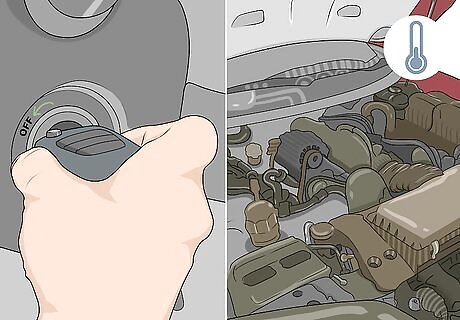
Turn the engine off and let become cool to the touch. If you have driven your car recently, wait about 30 minutes to 1 hour before attempting to change the clutch fluid level. Open the engine bay after giving the engine time to cool off. If you feel any heat coming from it, wait a little longer or put on heat-resistant gloves. Although you won’t be touching the engine, it can still burn you if you aren’t careful. Take proper precautions around a hot engine to prevent accidents.
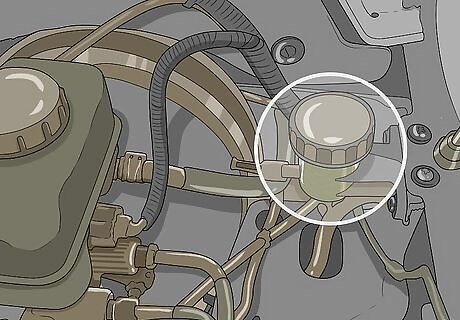
Locate a small, clear tank near the windshield in the engine bay. Pop open your car’s hood and take a look at the various engine components. The clutch fuel reservoir is typically near the windshield on the driver’s side. It will be transparent but topped with a black cap. Check the label on the cap to make sure you are looking at the correct reservoir. The engine bay contains also contains a brake fluid reservoir. It looks similar and is often located next to the clutch fuel reservoir. However, it is bigger and often square-shaped. If you don’t know what reservoir tank you are looking at, check the owner’s manual for more information. It will most likely have a diagram with all the engine bay components labeled. If you don’t have the manual, look online for one by searching for your car’s make and model.

Look at the side of the tank to note the fluid level. Modern clutch fluid reservoirs are made of a transparent plastic so you can easily spot the fluid level without ever having to touch the tank. The side of the tank will have lines labeled “minimum” and “maximum.” Check that the liquid inside the tank is close to the maximum line near the top or at least above the minimum line. Some old cars have metal reservoirs that you can’t see through. These require you to remove the cap in order to check the fluid level. Turn the cap counterclockwise by hand to detach it from the tank.
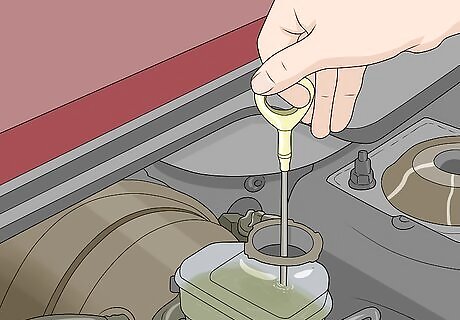
Check the fluid level with a dipstick if you can’t see it normally. If your vehicle has a reservoir tank you can’t see through, you can drop a thin measuring device called a dipstick into it. While gripping the dipstick by the handle, lower it into the reservoir until it reaches the bottom. Then, pull it back up and note how high the fluid is on it. If the tank is less than ⅔ of the way full, plan on topping it off with fresh fluid. You can purchase a dipstick, along with new hydraulic fuel and anything else you need, online or at an auto parts store.
Refueling the Clutch Fluid Reservoir
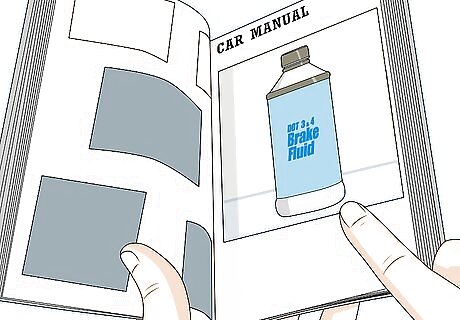
Select a hydraulic fluid indicated as safe for use in your owner’s manual. There are a couple of different fluids the manufacturer may recommend, so check the owner’s manual to find out which one is right for your car. Most vehicles use a brake fluid called DOT 3 or DOT 4, but check your car's manual for the recommended fluid. Some vehicles may use an alternative type labeled as hydraulic clutch fluid. Technically, there is no such thing as clutch fluid. The clutch fuel reservoir actually contains the same type of brake fluid used for the brake fluid. To make this less confusing, think of it as hydraulic fluid instead of clutch or brake fluid. Using the wrong type of fluid could cause damage to your vehicle. Make sure you use the type of fluid specified on the clutch tank cap or in the owner’s manual.

Put on rubber gloves before handling the fluid. Hydraulic fluid is pretty caustic and can be harmful if you’re not careful with it. Consider wearing a long-sleeved shirt as well for additional protection. If you get any fluid on your skin, rinse it off right away, making sure you don’t touch your eyes or mouth until your hands are clean. Wipe up spilled fluid right away with a paper towels, especially if it gets on the painted part of your vehicle. Clean up bigger spills with an absorbent material like cat litter.
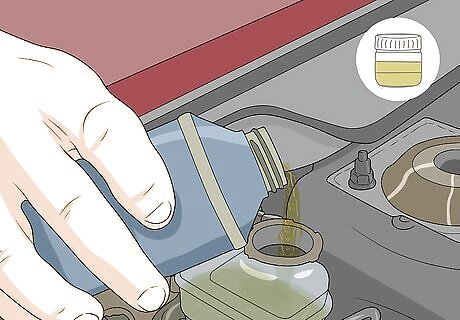
Add fluid to the reservoir until it is about ⅔ of the way full. To ensure the fluid doesn’t spill, consider placing a plastic funnel on top of the reservoir. Pour the fluid in gradually, taking your time to avoid spills. Fill the reservoir up to the maximum marking if the reservoir has one — never go over the maximum line. It doesn’t have to be filled to the brim. If the tank is too full, the fluid could spill or otherwise flood your vehicle’s clutch system. Stop and clean spills right away as soon as you notice them.
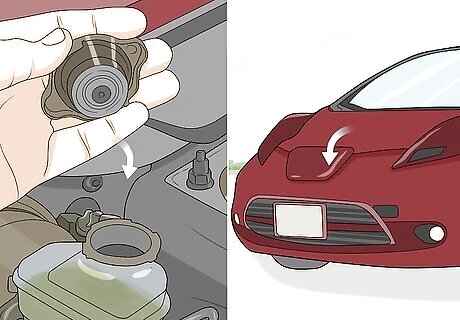
Replace the reservoir cap and close the hood. The cap has a rubber gasket inside of it. Make sure it sits securely over the reservoir opening, Then, turn the cap clockwise until it locks into place. As long as the tank is well-sealed, your car is ready for use again. Make sure the cap is on tightly. If it is loose, it could leak fluid or let air into the reservoir. Air stops the clutch system from working correctly, and the only way to remove it is by draining fluid.
Diagnosing Clutch Fluid Problems
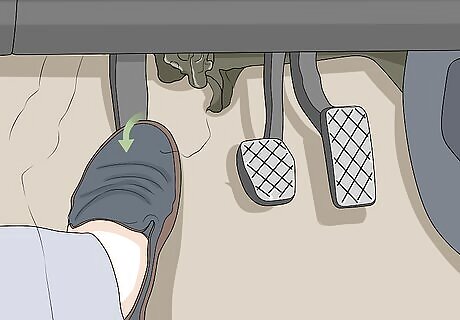
Press the clutch pedal to see if it moves with ease. Sit in the driver’s seat and step down hard on the clutch pedal a few times. When you press down on the pedal, it should move smoothly and spring up right each time. If you’re having a hard time moving the pedal with any consistency, then the clutch fluid level has likely run low. It could also be from air getting into the clutch fluid reservoir. The fluid lubricates the clutch so it responds when you use it to control the car’s speed. Without it, the mechanical components wear out at a much faster rate. Air bubbles prevent the clutch from engaging properly and are often caused by leaks. If you have replaced the clutch fluid recently, that could also cause air to get into the reservoir.

Drive the car to see if you can shift gears while operating the clutch. Starting with the car in first gear, press down on the clutch to build up speed. Press it again when the engine reaches about 2,000 RPM and shift into second gear. Watch for anything out of the ordinary, such as the vehicle lurching, a stuck clutch, or a grinding noise. Visit a mechanic right away to solve most of these problems. For something like a stuck clutch, check the fluid level first. A drained reservoir will prevent the clutch from working. Transmission problems are very serious and difficult to repair at home. Don’t ignore signs like grinding gears or a clutch that won’t work at all.
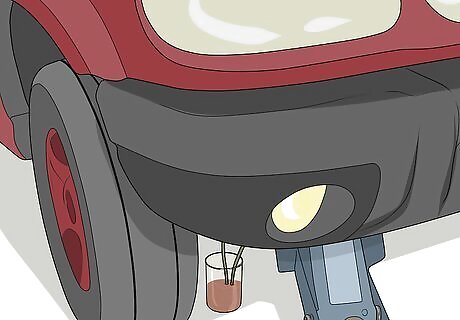
Drain and replace the clutch fluid if it looks dark.. Fresh clutch fluid has a clear yellow coloring. It darkens, turning red or black, over time. If the fluid looks dirty, bleed it from the clutch valve underneath your vehicle. If it still looks clear, simply top off the reservoir tank as needed with new fluid. Bleeding the valve requires you to jack up the vehicle’s front end and get under it. Once you find the valve, you attach a rubber hose to it and press the clutch to drive out the fluid. However, keep the tank full by adding new fluid after every couple of presses. If you’re uncertain about doing this on your own, contact a mechanic to have them deal with the clutch fluid. Jacking up a car is dangerous when it isn’t done properly.
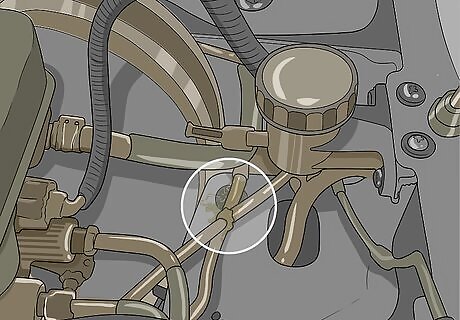
Inspect the fluid reservoir and surrounding components for leaks. Like any other car parts, the components responsible for operating the clutch wear out over time. Open the engine bay and examine the clutch fluid reservoir. Have a friend press the clutch pedal down while you keep an eye on the fluid level. Check the reservoir tank and the parts around it for leaked fluid. If you notice a leak, get an identical replacement part or take the vehicle to a professional right away. You may not notice small leaks right away. One easy way to spot hidden leaks is by noting the fluid level, then checking it again after several days. If it has changed by a noticeable amount, then your vehicle needs repairs.
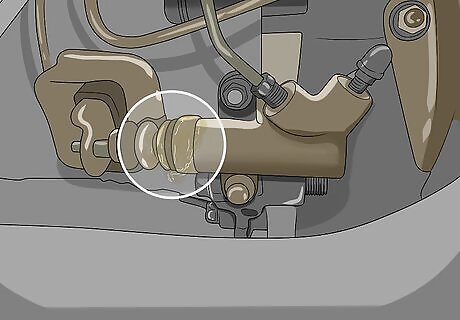
Look at the clutch lines and slave valve underneath the car for leaks. The slave cylinder is a small component located above the transmission on your engine. To find it, follow the cables running from the clutch reservoir to the engine. Have a friend press the clutch pedal a few times while you watch for the slave cylinder to move. Check it for leaks or bubbles as well. If the cylinder doesn’t move, it has to be replaced. Take the vehicle to a mechanic. Leaks can be fixed by replacing parts. Have a mechanic do it if you are unable to do it on your own. If you do it on your own, you will need to bleed out the clutch valve afterward.


















Comments
0 comment